Ecolab 92053007 NEXA Manual Dispenser Beacon User Manual FCC Part 15
Ecolab Inc. NEXA Manual Dispenser Beacon FCC Part 15
Ecolab >
Manual
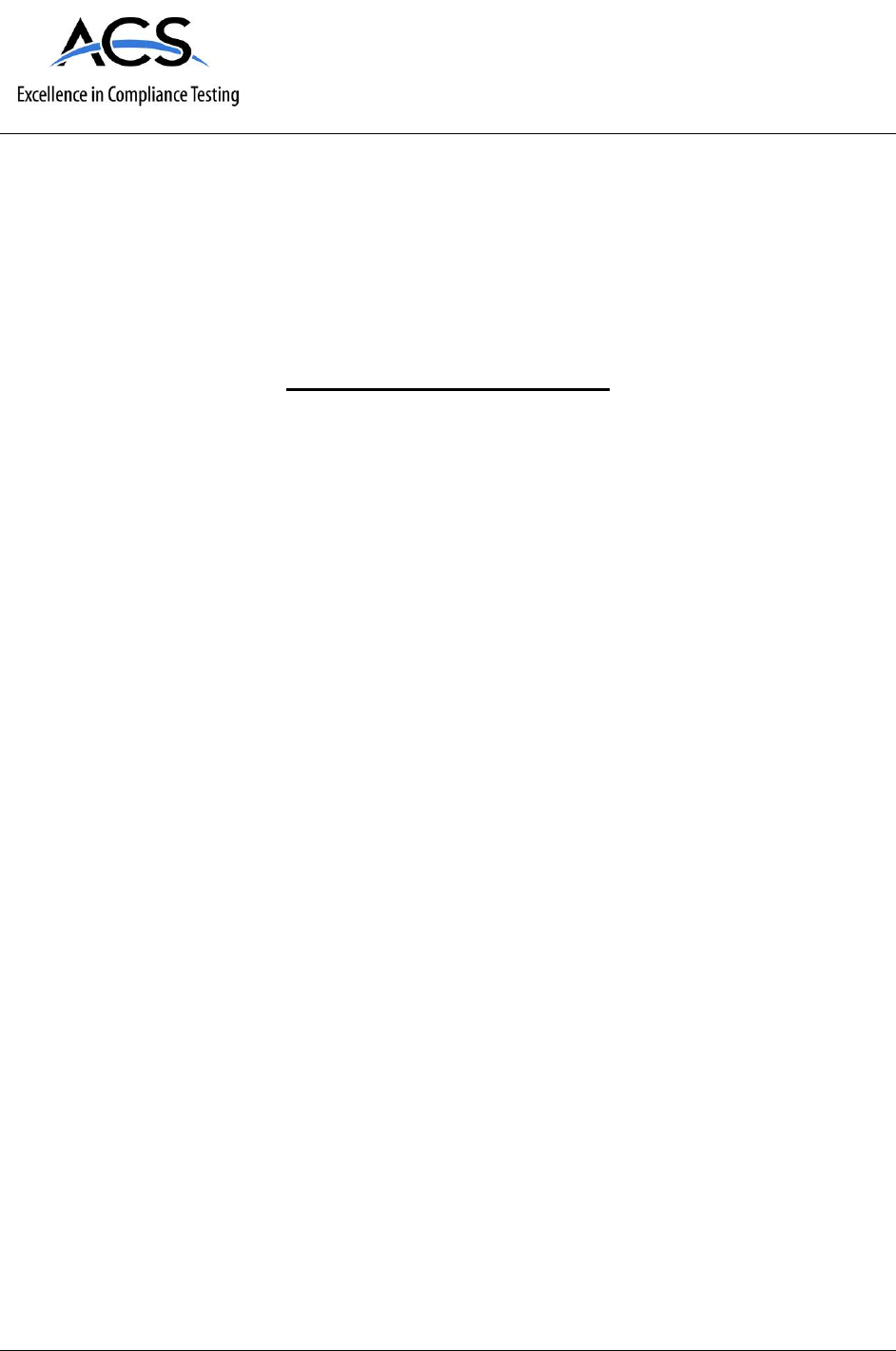
3998 FAU Blvd. Suite 310 Boca Raton, FL 33431 Tel: 561-961-5585 Fax: 561-961-5587
Certification Exhibit
FCC ID: Z9O-92053007
IC: 10060A-92053007
FCC Rule Part: 15.209, 15.231, 15.249
ISED Canada Radio Standards Specification: RSS-210
ACS Project: 16-2077
Manufacturer: Ecolab, Inc.
Model: 92053007
User Manual
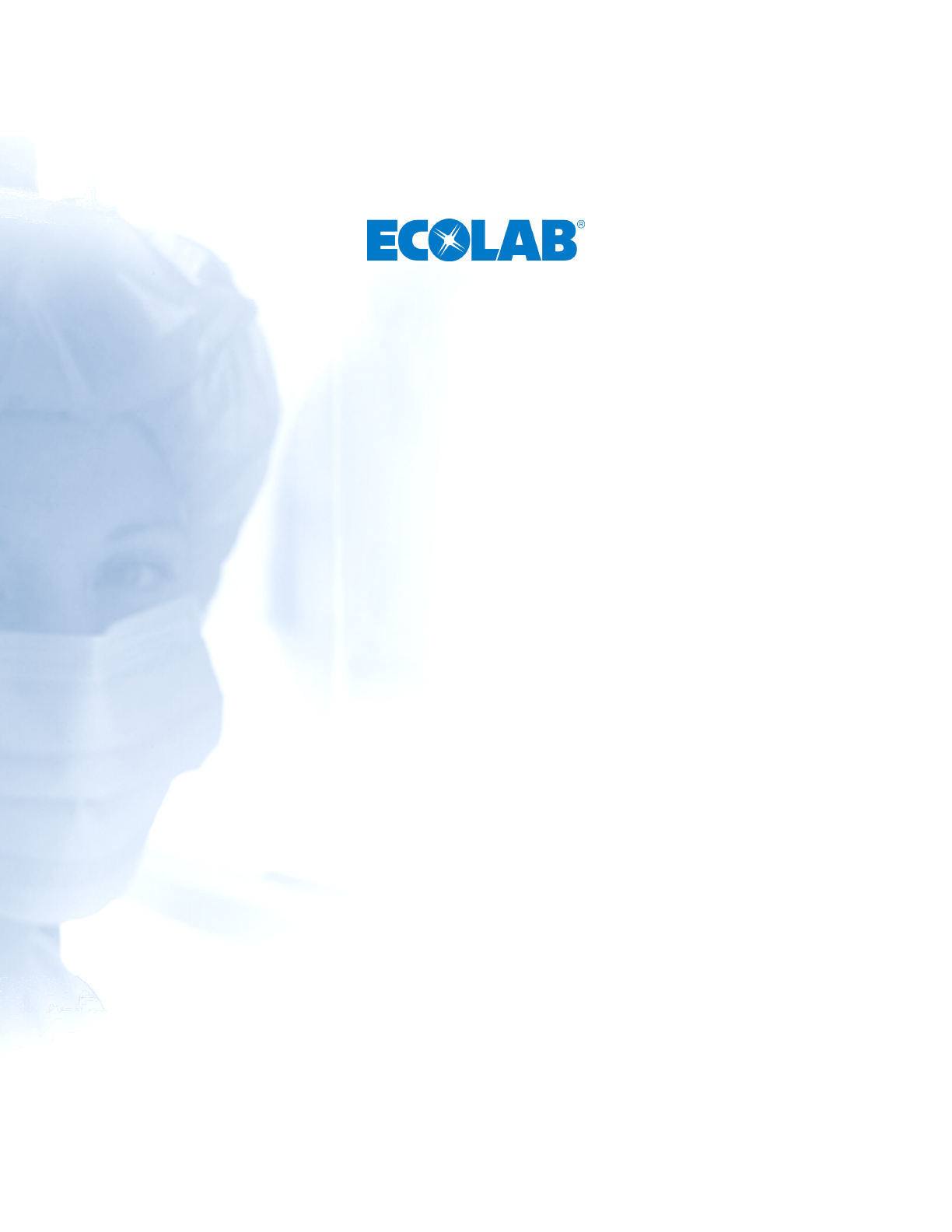
HH 360
®
Nexa™ Manual Dispenser Beacon User’s Guide
Revision 0

HH 360™ Nexa™ Manual Dispenser Beacon User’s Guide
Ecolab
Page 1
Table of Contents
Abstract........................................................................................................................................................................................ 3
Revision History ........................................................................................................................................................................... 3
Reference Documents ................................................................................................................................................................. 3
Terms, Acronyms and Abbreviations ........................................................................................................................................... 3
1. Introduction to the Ecolab HH 360
TM
System (HH 360
TM
) ....................................................................................................... 4
1.1 Hardware Components ...................................................................................................................................................... 4
1.1.1 Healthcare Worker Badge .......................................................................................................................................... 4
1.1.2 Dispenser Beacon ...................................................................................................................................................... 4
1.1.3 Bed Beacon ................................................................................................................................................................ 4
1.2 Bentley™ Wireless Network ............................................................................................................................................... 4
1.2.1 Hubs ........................................................................................................................................................................... 4
1.2.2 Gateway ..................................................................................................................................................................... 4
1.3 Dashboard and Offsite Server ............................................................................................................................................ 5
2. Nexa Manual Dispenser Beacon Overview .............................................................................................................................. 6
3. Manual Dispenser Beacon Set Up ............................................................................................................................................ 6
3.1 Installing Batteries ............................................................................................................................................................. 6
3.2 Adjusting Communication Range ....................................................................................................................................... 6
3.3 Installing the Manual Dispenser Beacon in a Nexa™ Manual Dispenser ........................................................................... 7
3.4 Removal of the Manual Dispenser Beacon from a Nexa™ Manual Dispenser. ................................................................. 8
4. How the Manual Dispenser Beacon Works. ............................................................................................................................ 9
4.1 Interaction with a Healthcare Worker’s Badge.................................................................................................................. 9
4.2 Interaction with a Hub ....................................................................................................................................................... 9
5. Dispenser Beacon Status Information ................................................................................................................................... 10
5.1 Yellow LED – Successful Communication Between HCW Badge and Dispenser Beacon. ................................................ 10
6. Manual Dispenser Beacon Care and Maintenance ................................................................................................................ 10
6.1 Handling ........................................................................................................................................................................... 10
6.2 Cleaning ........................................................................................................................................................................... 10
6.3 Battery Replacement ....................................................................................................................................................... 10
6.3.1 Supplies .................................................................................................................................................................... 10
6.3.2 Battery Replacement Steps...................................................................................................................................... 10
Appendix A - Certification and Safety Approvals ....................................................................................................................... 12
Appendix B - HH 360™ Radio Frequency Transmission Safety Concerns .................................................................................. 13
Appendix C - Warranty............................................................................................................................................................... 13

HH 360™ Nexa™ Manual Dispenser Beacon User’s Guide
Ecolab
Page 2
Figures
Figure 1.
HH 360
TM
System Overview ................................................................................................................................... 5
Figure 2.
Back view, showing, battery door tab, and range button locations ...................................................................... 6
Figure 3.
Front view, showing LED Tunnel, Retention tab, and Removal strap .................................................................... 7
Figure 4.
Interior view showing beacon installation opening ............................................................................................... 8
Figure 5.
Beacon Installed in Dispenser ................................................................................................................................ 8
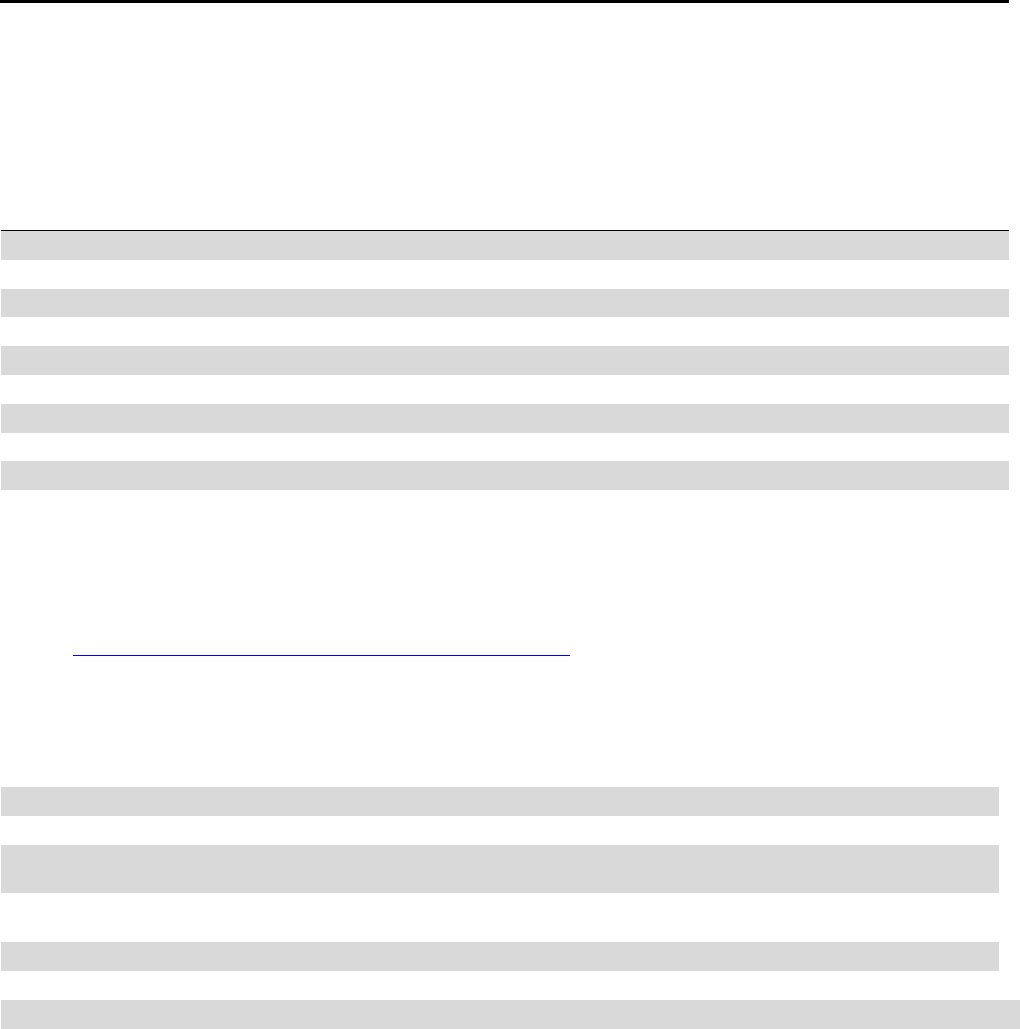
HH 360™ Nexa™ Manual Dispenser Beacon User’s Guide
Ecolab
Page 3
Abstract
This document describes basic setup, function, use and maintenance for the HH 360 Healthcare Manual Dispenser Beacon
(92053007).
Revision History
Revision Date By Description
0 12/13/16 CAL Initial Release
Reference Documents
• HH 360 Badge States Handout
• World Health Organization “Your 5 Moments for Hand Hygiene”
http://www.who.int/gpsc/5may/background/5moments/en/
Terms, Acronyms and Abbreviations
Factory Default
A Badge setting or parameter that is programmed with an initial default value by the manufacturer
but that may be modified by the healthcare facility.
HCW
Healthcare Worker
LED
Light Emitting Diode
Patient Contact
Having physical contact with a patient, their immediate surroundings or being in close proximity to a
HH 360
TM
equipped patient bed.
Patient Zone
The area around a patient bed that is detectable by a HH 360™ Badge. Being inside the patient zone
will be considered patient contact.
HH 360™
Ecolab HH 360™ System for electronic Hand Hygiene monitoring
WHO
World Health Organization
MDB
Manual Dispenser Beacon

HH 360™ Nexa™ Manual Dispenser Beacon User’s Guide
Ecolab
Page 4
1. Introduction to the Ecolab HH 360
TM
System (HH 360
TM
)
The HH 360
TM
System is a state of the art wireless hand hygiene reminder system designed to enable best practices for
proper hand hygiene in a healthcare facility. Multiple studies from organizations like the World Health Organization (WHO)
and the Centers for Disease Control (CDC) have repeatedly demonstrated that proper hand hygiene leads directly to
improved infection control and a reduction in Healthcare Associated Infections (HAI). The HH 360
TM
System is a cost-
effective, energy efficient, robust and easily installed system for coaching healthcare workers (HCWs) to always wash or
sanitize their hands before and after patient contact. The system can be divided into three parts, hardware components,
the Bentley Wireless Network and the Dashboard web-based application.
1.1 Hardware Components
The HH 360
TM
System is built on individual components or devices that work in concert to deliver real-time individual
hand hygiene status to HCWs and near real-time statistics for both onsite and offsite monitoring of current and
historical hand hygiene compliance data. Currently, the wireless components of the HH 360
TM
System are the HCW
Badge, the Dispenser Beacons and the Bed Beacon.
1.1.1 Healthcare Worker Badge
The Badge is a wireless device worn by the HCW to provide real-time notification of the HCW’s current hand hygiene
status. Notification is provided by both visual and audible alerts. The Badge is responsible for determining,
maintaining and transmitting the current hand hygiene status of the HCW to other HH 360
TM
components.
1.1.2 Dispenser Beacon
The Dispenser Beacon is attached to or embedded within a soap or sanitizer dispenser. Its function is to
communicate with the Badge worn by the HCW when the dispenser is activated (dispense event), collect dispense
event data from that Badge and then transmit the collected data to a network where it will ultimately be sent to an
offsite server for processing and archiving.
1.1.3 Bed Beacon
The Bed Beacon is mounted to a patient bed. Its function is to communicate with the Badge worn by the HCW,
when the HCW comes in close proximity with the patient bed (bed event), collect bed event data from that Badge,
and then transmit the collected data to a network where it will ultimately be sent to an offsite server for processing
and archiving.
1.2 Bentley™ Wireless Network
Bentley is a wireless mesh network used to transport event data collected by Dispenser Beacons and Bed Beacons to the
offsite server for processing and archiving. Bentley is composed of two types of devices: Hubs and a Gateway.
1.2.1 Hubs
Hubs are installed throughout a healthcare facility and communicate with nearby Bed Beacons and Dispenser
Beacons. When an event is generated by a Beacon, it broadcasts the event data to the nearest Hub. The Hub then
receives the event data and rebroadcasts it to the Gateway (if it is in range) or to the next nearest Hub with the data
being passed from Hub to Hub until it reaches the Gateway.
1.2.2 Gateway
The Gateway receives event data generated by Dispenser Beacons or Bed Beacons directly, if they are in range, or
from Hubs which act as repeaters. The Gateway then transmits the event data to an offsite server via cellular
modem, for processing and archiving.
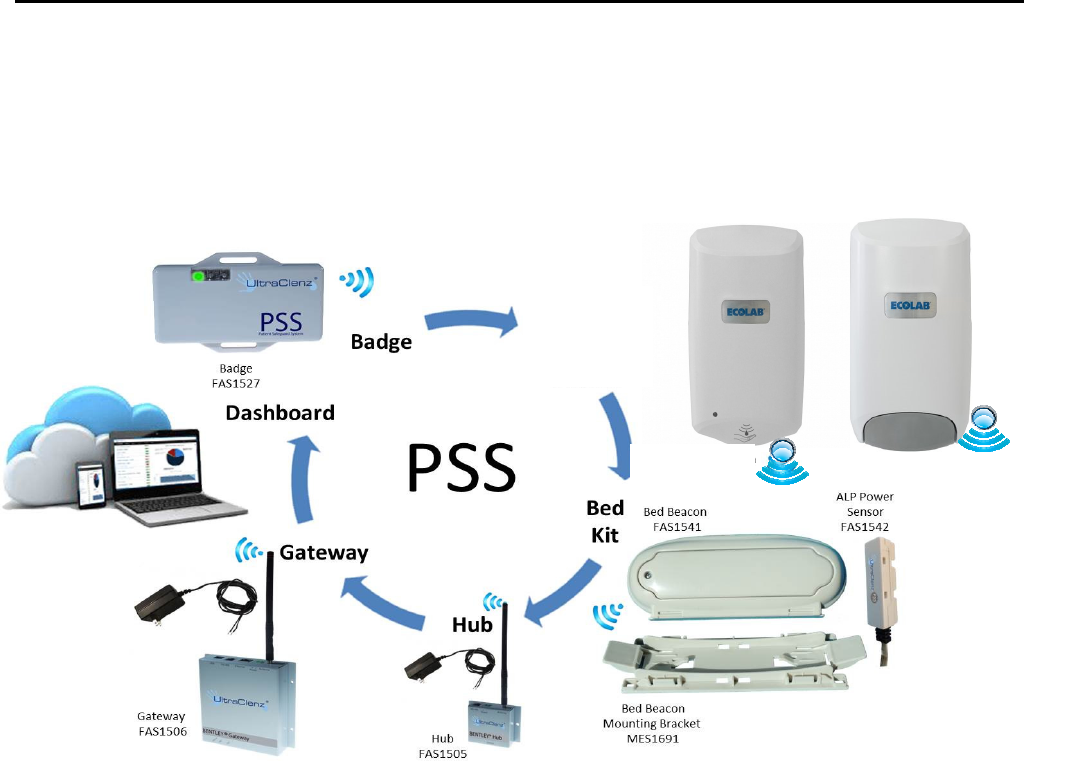
HH 360™ Nexa™ Manual Dispenser Beacon User’s Guide
Ecolab
Page 5
1.3 Dashboard and Offsite Server
The Dashboard is a web-based application running on a designated offsite server. It is responsible for collecting,
processing and archiving onsite Dispenser Beacon and Bed Beacon event data sent by the onsite Gateway. The
Dashboard provides a user interface which allows access to hand hygiene data, statistics and reports compiled from
event data originating at the healthcare facility.
Figure 1. HH 360
TM
System Overview
Nexa™
Dispenser
Beacon
Touchfree
Dispenser Beacon
FAS1548
Manual
Dispenser Beacon
FAS1540
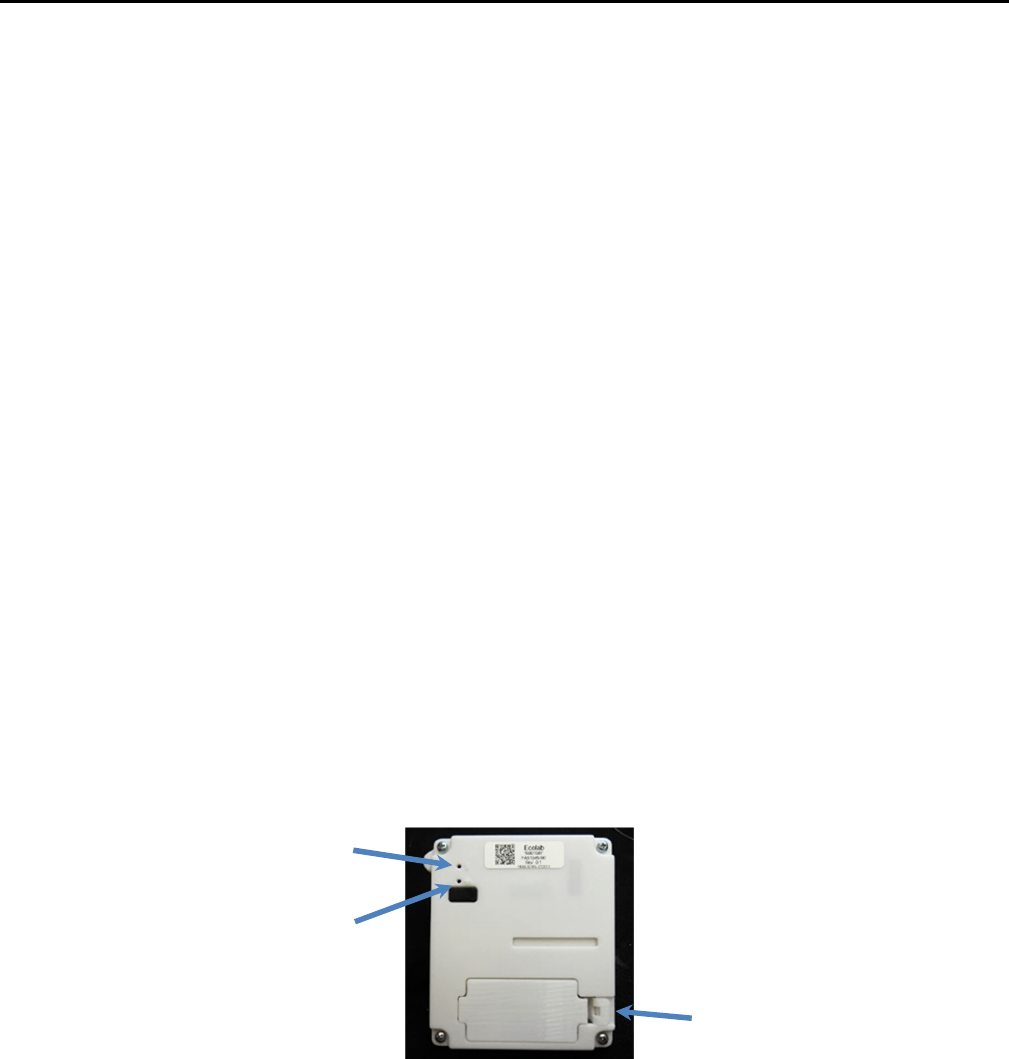
HH 360™ Nexa™ Manual Dispenser Beacon User’s Guide
Ecolab
Page 6
2. Nexa Manual Dispenser Beacon Overview
The Nexa Manual Dispenser Beacon (part number 92053007) is an integral component of the HH 360™ System (HH 360™).
When the HH 360™ System is installed, Healthcare facilities determine which dispensers they wish to have monitored, and
a beacon is installed in those dispensers. Each Dispenser Beacon has a unique identification address that is associated to a
specific physical location during the install process.
The Dispenser Beacon communicates with the Healthcare Worker Badges to obtain Badge ID and Status information during
a dispense event. The dispense event communication sets the HCW Badge’s status to “Green” or “State 0” and then both
the dispenser and the HCW badge ID information is transmitted by the dispenser beacon to the nearest Hub, along with the
time and date of the event, to be relayed to the offsite server for data compilation. Once the information exchange
between the Dispenser Beacon and the HCW Badge is complete, the module LED will light up Yellow to indicate that the
HCW has been credited with the dispense event.
3. Manual Dispenser Beacon Set Up
3.1 Installing Batteries
Each Manual Dispenser Beacon (MDB) requires 2 AA alkaline batteries for operation. These must be installed prior to
initial installation of the MDB in the dispenser. The door to the MDB battery compartment can be found on the back of
the device.
To install batteries prior to initial installation, complete the following steps:
1.
Remove the battery compartment door by gently pulling back on the tab and lifting away from the MDB.
2.
Once the battery compartment door has been removed, install two (2) AA alkaline batteries, aligning the
positive (+) and negative (-) terminals of the batteries with the corresponding signs displayed within the
battery compartment (Ecolab recommends that only Duracell® Coppertop batteries be used to power the
MDB).
3.
Once the batteries have been installed, replace the battery compartment door and make sure that it is firmly
in place before installation.
Figure 2. Back view, showing, battery door tab, and range button locations
3.2 Adjusting Communication Range
The range buttons (see Figure 2) are used to increase or decrease the communications distance (range) between the
MDB and HCW Badge. The range buttons are accessed via ports on the backside of the MDB. Use a non-electrically
conductive (not metal) instrument such as a tooth pick to gently press the buttons. When a button has been pressed,
the LED will flash. The increase range button is marked with a “+” sign next to the access port. The decrease range
button is marked with a “-” sign next to the access port.
Battery Door Tab
“-“ Range Button
“+” Range Button
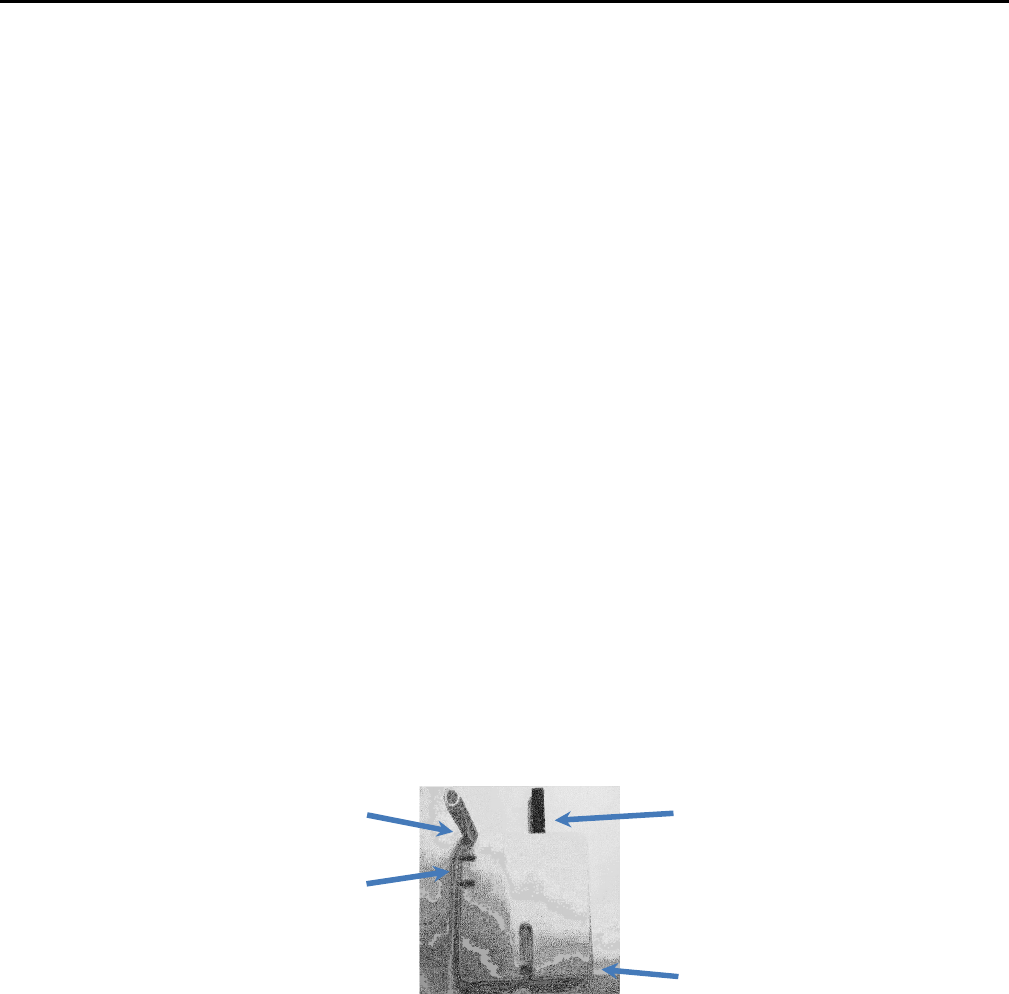
HH 360™ Nexa™ Manual Dispenser Beacon User’s Guide
Ecolab
Page 7
To increase the communication range, do the following:
1. Press and release the “+” range button. The Green LED will flash one (1) time for each push of the switch until
maximum range has been reached. The Green LED will flash two (2) times when at maximum range.
2. Repeat step 1 until the desired range has been reached.
To decrease the communication range, do the following:
1. Press and release the “-“ range button. The RED LED will flash one (1) time for each push of the switch until
minimum range has been reached. The Red LED will flash two (2) times when at the minimum range.
2. Repeat step 1 until the desired range has been reached.
To set the range to the factory default, press and hold both the “+” and “-“ range buttons until the LED flashes Yellow
four (4) times.
3.3 Installing the Manual Dispenser Beacon in a Nexa™ Manual Dispenser
The Nexa MDB can be used in either the large (“Classic”) or small (“Compact) version of the Nexa Manual Dispenser.
Only the Classic version is shown in the following figures.
In order to install the beacon follow these steps:
(1) Open the dispenser by depressing the top latch button.
(2) Remove product bottle (if any) from the dispenser and set aside.
(3) Align the bottom of the beacon with the opening in the back of the dispenser (see Figures 3 and 4).
(4) Gently slide the beacon into the compartment at the back of the dispenser, until a soft click is heard,
indicating that the module is installed in the compartment.
(5) Replace the product bottle within the dispenser.
(6) Close the dispenser.
Figure 3. Front view, showing LED Tunnel, Retention tab, and Removal strap
Removal strap
Bottom of Beacon
LED Tunnel
Retention Tab
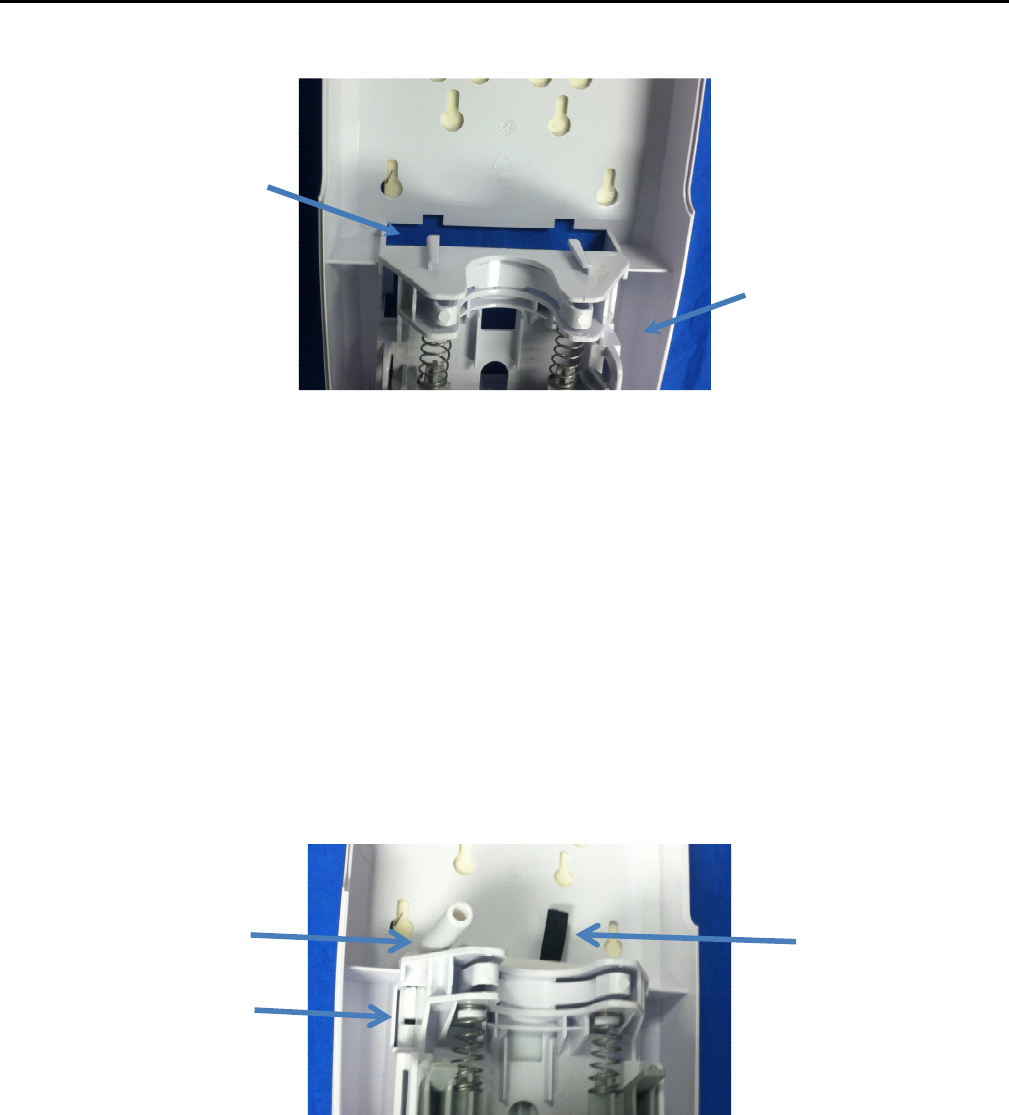
HH 360™ Nexa™ Manual Dispenser Beacon User’s Guide
Ecolab
Page 8
Figure 4. Interior view showing beacon installation opening and Nexa Manual Dispenser (Interior View)
3.4 Removal of the Manual Dispenser Beacon from a Nexa™ Manual Dispenser.
The Nexa MDB can be used in either the large (“Classic”) or small (“Compact) version of the Nexa Manual Dispenser.
Only the Classic version is shown in the following illustrations.
To remove the beacon, follow these steps:
(1) Open the dispenser by depressing the top latch button.
(2) Remove product bottle (if any) from the dispenser and set aside
(3) With one hand, gently depress the retention tab (see figure 5) to release the beacon and allow it to be
removed.
(4) With the other hand, gently pull on the removal strap at the top of the MDB to lift the MDB out of the
compartment at the back of the dispenser.
Figure 5. Beacon Installed in Dispenser
Bottom of Dispenser
Opening for Beacon
Removal Strap
Retention T
ab
LED Tunnel

HH 360™ Nexa™ Manual Dispenser Beacon User’s Guide
Ecolab
Page 9
4. How the Manual Dispenser Beacon Works.
The HH 360™ MDB is a wireless device that detects and communicates with HH 360™ HCW badges and Hubs. The MDB
communicates with a HCW badge based on its proximity to the device. When the HCW dispenses soap or sanitizer by
pushing the dispenser push bar, a proximity bubble is created around the dispenser which wakes up the HCW Badge and
begins the information exchange between the devices. The dispenser then communicates time, date, badge status and ID
information (the dispenser ID and badge ID) to a Hub, which relays it on to the remote server.
4.1 Interaction with a Healthcare Worker’s Badge
When the manual dispenser push bar is depressed at least 75% of a full stroke, the attached HH 360™ MDB will
momentarily create a proximity bubble around itself and the dispenser. If the Badge worn by the HCW activating the
dispenser is within the proximity bubble, the Badge will communicate with the MDB and then change to the proper
hand hygiene status level. If the Badge is not within the proximity bubble, it will not communicate with the MDB nor
will its hand hygiene status level change. This will result in the HCW not receiving credit for using the dispenser.
The default range of the MDB’s proximity bubble is about 24 inches in all directions but the range can be adjusted if
necessary. It is important for the HCW to wear their Badge in a location that insures it is within the MDB’s proximity
bubble whenever a dispenser is activated. It is also important that only one Badge is within the proximity bubble when
a dispenser is activated. If more than one Badge is within the proximity bubble, the MDB may unintentionally
communicate with the wrong Badge (i.e., a Badge belonging to a HCW that did not activate the dispenser). If this
happens, the wrong Badge will change its hand hygiene status level and the wrong HCW will receive credit for using the
dispenser.
Every Dispenser Beacon is equipped with at least one user feedback LED. This LED will only flash when the MDB has
successfully communicated with a Badge. The LED flash will occur during or immediately after dispenser activation. If
the LED does not flash, the Badge may not have been within the proximity bubble or there was an error in
communications. If this occurs, the HCW should move closer to the dispenser and activate it again.
Please take the following steps to insure proper Badge communications and correct HCW credit when using a dispenser.
1. Verify that the Badge is being worn in a location that will be within a MDB’s 24-inch proximity bubble.
2. Before activating a dispenser, verify that other HCWs are not within the MDB’s 24-inch proximity bubble. If
there are other HCWs near the dispenser, kindly ask them to move away before activating.
3. Verify that the MDB’s LED flashed when the attached dispenser was activated. If the LED did not flash, move
closer to the dispenser and activate it again.
4.2 Interaction with a Hub
All MDBs are equipped with a longer-range radio that allows them to transmit information to the HH 360™ System’s
Hubs. The MDB will transmit to the Hub that is closest to it or from which it gets the strongest signal. At time of system
install, it is verified that all MDBs are in range of at least one Hub.
When the manual dispenser push bar is depressed at least 75% of a full stroke, the MDB is activated, will create a
proximity bubble and search for HCW badges. If the user is wearing a badge, the Badge’s HH status will be updated by
the MDB. The MDB will then transmit the Badge’s HH status just prior to and immediately after the dispense to the
Hub. The MDB will also transmit the time, date and location of the event, along with the battery status of the HCW
badge and the MDB. If the user is not wearing a badge, or is not within the proximity bubble, the time, date and
dispenser ID for the product dispense event will be relayed to the hub as a “non-badged dispense”.
In addition to communication of dispense event data, all MDBs proactively send their ID and battery status information
to a Hub on an approximately hourly basis. If communication to a Hub is lost, all MDBs have the capability to store up to
100 events

HH 360™ Nexa™ Manual Dispenser Beacon User’s Guide
Ecolab
Page 10
5. Dispenser Beacon Status Information
The Dispenser Beacon proactively sends its battery level and status information to a Hub at least once per hour, or when
product is dispensed. This information can be accessed through the Dashboard, to generate a report showing Dispenser
Beacons with low battery level. If communication to a Hub is temporarily lost, each MDB has the capability to store up to
512 events. If this number of events is exceeded before communication to the Hub is restored, the oldest events will be
overwritten, thus resulting in some loss of data.
5.1 Yellow LED – Successful Communication Between HCW Badge and Dispenser Beacon.
The Yellow LED which flashes once during or immediately after a dispense event, indicates that the HCW badge
information has successfully been communicated to the Dispenser Beacon. The Dispenser Beacon will then send this
information to a Hub for relay on to a Gateway, and eventually to the offsite server for compilation and archiving.
6. Manual Dispenser Beacon Care and Maintenance
6.1 Handling
The MDB is an electronic device and should be handled with care. Like other electronic devices such as a cell phone, the
MDB must be protected from extreme heat, cold and moisture. Avoid handling the MDB with wet hands or exposing it
to water. Dropping or tossing the MDB can result in damage to the internal electronics.
6.2 Cleaning
Under normal conditions of use, the MDB should not require cleaning. On the infrequent occasions where the MDB
might become soiled, it should be cleaned by wiping with a soft cloth. The cloth may be dry or slightly damp but not
wet. Only the exterior of the MDB may be cleaned. Do not attempt to clean any interior surface of the MDB, as this can
damage the circuitry. Do not use abrasive cleaners or spray cleaning products.
6.3 Battery Replacement
Typical Dispenser Beacon battery life is about 1 year but this may vary depending on use. When a Dispenser Beacon’s
battery is dead it will no longer communicate with other HH 360™ devices. The HH 360™ Dashboard software also
monitors the battery level of each MDB. It will send an email alert to a designated maintenance person assigned by the
healthcare facility when a MDB’s batteries are low (20% or less remaining battery capacity). The maintenance person
should replace the batteries as soon as possible to prevent loss of data.
6.3.1 Supplies
The following supplies are required to replace the Manual Dispenser Beacon’s battery:
1. Two (2) alkaline AA Duracell® Coppertop Batteries
6.3.2 Battery Replacement Steps
The following steps describe how to remove the MDB from the Nexa Manual Dispenser, and replace the batteries:
1. Open the dispenser by depressing the top latch button.
2. Remove product bottle (if any) from the dispenser and set aside.
3. With one hand, gently depress the retention tab (see figure 5) to release the beacon and allow it to be
removed.
4. With the other hand, gently pull on the removal strap at the top of the MDB to lift it out of the
compartment at the back of the dispenser.
5. Holding the MDB so that the rear side is facing up, remove the battery compartment door by gently pulling
back on the battery door tab.

HH 360™ Nexa™ Manual Dispenser Beacon User’s Guide
Ecolab
Page 11
6. Once the battery compartment door has been removed, install two (2) AA alkaline batteries, aligning the
positive (+) and negative (-) terminals of the batteries with the corresponding signs displayed within the
battery compartment (Ecolab recommends that only Duracell® Coppertop batteries be used to power the
module.)
7. Once the batteries have been installed, replace the battery compartment door and make sure that it is
firmly in place before replacing the MDB in the dispenser.
8. To replace the MDB in the Nexa Manual Dispenser, align the bottom of the beacon with the opening in the
back of the dispenser (see Figures 3 and 4).
9. Gently slide the beacon into the compartment at the back of the dispenser, until a soft click is heard,
indicating that the module is installed in the compartment.
10. Replace the product bottle within the dispenser.
11. Close the dispenser.
12. Dispose of the old batteries. Check with the healthcare facility for the proper disposal procedure.

HH 360™ Nexa™ Manual Dispenser Beacon User’s Guide
Ecolab
Page 12
Appendix A - Certification and Safety Approvals
FCC Statement
NOTE: This equipment has been tested and found to comply with the limits for a Class B digital device, pursuant to Part 15 of the FCC
Rules. These limits are designed to provide reasonable protection against harmful interference in a residential installation. This
equipment generates, uses, and can radiate radio frequency energy and, if not installed and used in accordance with the instructions,
may cause harmful interference to radio communications. However, there is no guarantee that interference will not occur in a
particular installation. If this equipment causes harmful interference to radio or television reception, which can be determined by
turning the equipment off and on, the user is encouraged to try and correct the interference by one or more of the following
measures:
• Reorient or relocate the receiving antenna.
• Increase the separation between the equipment and receiver
• Connect the equipment into an outlet on a circuit different from that to which the receiver is connected.
• Consult the dealer or an experienced radio/TV technician for help.
WARNING: Changes or modifications not expressly approved by Ecolab could void the user’s authority to operate the equipment.
RF Exposure: This equipment complies with FCC radiation exposure limits set forth for an Uncontrolled environment. This equipment
should be installed and operated with minimum distance 20cm between the radiator and your body. This transmitter must not be
co-located or operating in conjunction with any other antenna or transmitter.
Industry Canada
Under Industry Canada regulations, this radio transmitter may only operate using an antenna of a type and maximum (or lesser) gain
approved for the transmitter by Industry Canada. To reduce potential radio interference to other users, the antenna type and its gain
should be so chosen that the equivalent isotropically radiated power (e.i.r.p.) is not more than that necessary for successful
communication.
Conformément à la réglementation d'Industrie Canada, le présent émetteur radio peut fonctionner avec une antenne d'un type et d'un
gain maximal (ou inférieur) approuvé pour l'émetteur par Industrie Canada. Dans le but de réduire les risques de brouillage
radioélectrique à l'intention des autres utilisateurs, il faut choisir le type d'antenne et son gain de sorte que la puissance isotrope
rayonnée équivalente (p.i.r.e.) ne dépasse pas l'intensité nécessaire à l'établissement d'une communication satisfaisante.
This device complies with Industry Canada license-exempt RSS standard(s). Operation is subject to the following two conditions: (1)
this device may not cause interference, and (2) this device must accept any interference, including interference that may cause
undesired operation of the device.
Le présent appareil est conforme aux CNR d'Industrie Canada applicables aux appareils radio exempts de licence. L'exploitation est
autorisée aux deux conditions suivantes: (1) l'appareil ne doit pas produire de brouillage, et (2) l'utilisateur de l'appareil doit accepter
tout brouillage radioélectrique subi, même si le brouillage est susceptible d'en compromettre le fonctionnement.
This radio transmitter (IC: 10060A-FAS1531) has been approved by Industry Canada to operate with the antenna types listed below
with the maximum permissible gain and required antenna impedance for each antenna type indicated. Antenna types not included in
this list, having a gain greater than the maximum gain indicated for that type, are strictly prohibited for use with this device.
Le présent émetteur radio (IC: 10060A-FAS1531) a été approuvé par Industrie Canada pour fonctionner avec les
types d'antenne énumérés ci-dessous et ayant un gain admissible maximal et l'impédance requise pour chaque type d'antenne. Les
types d'antenne non inclus dans cette liste, ou dont le gain est supérieur au gain maximal indiqué, sont strictement interdits pour
l'exploitation de l'émetteur.
Magnetic Loop Antenna
Printed-F antenna, 6.3 dBi
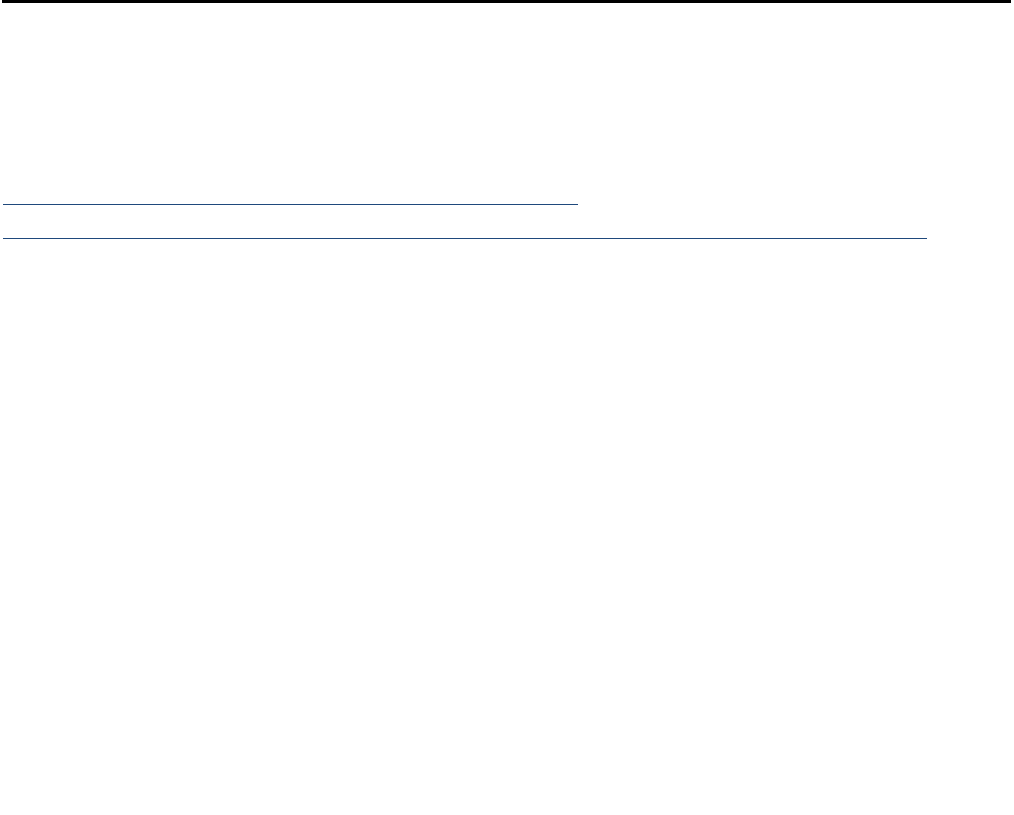
HH 360™ Nexa™ Manual Dispenser Beacon User’s Guide
Ecolab
Page 13
Appendix B - HH 360™ Radio Frequency Transmission Safety Concerns
The frequency of transmission of this HH 360 device is 2.4GHz occupying the same frequency space as "Bluetooth" devices, but this
device operates at much lower energy with a much smaller transmission package and rate of transmission. Therefore, we believe the risk
associated with this device is minimized and far less than that of commercially available Bluetooth devices.
Further information can be found on the FCC website here:
https://www.fcc.gov/consumers/guides/wireless-devices-and-health-concerns
https://www.fcc.gov/engineering-technology/electromagnetic-compatibility-division/radio-frequency-safety/faq/rf-safety#Q7
Appendix C - Warranty
This device is warranted against defective materials and workmanship for two years from the date of purchase.
Equipment covered by this warranty will be repaired or replaced in the United States and Canada, WITHOUT CHARGE, except for shipping
and handling, by our Factory Service Center.
When returning equipment for warranty service, you must first call your distributor’s Warranty Service Department for your Return
Merchandise Authorization Number (RMA). The RMA must be on your return label and the shipping charges must be pre-paid and a copy
of your receipt must be enclosed.
This warranty covers all defects incurred from normal use of the equipment and does not apply in the following cases:
a. Loss or damage to the equipment due to abuse, mishandling, accident or failure to follow installation or use instructions.
b. If the equipment is defective as a result of leaking batteries.
c. If the equipment has been serviced or modified by someone other than our authorized agents.
THE AFOREMENTIONED IS IN LIEU OF ALL WARRANTIES, EXPRESSED OR IMPLIED, INCLUDING BUT NOT LIMITED TO, ANY WARRANTY OF
MERCHANTABILITY OR OF FITNESS FOR ANY PARTICULAR PURPOSE. IN NO EVENT SHALL THE VENDOR BE LIABLE FOR CONSEQUENTIAL,
INCIDENTAL, INDIRECT OR SPECIAL DAMAGES OR LIABILITY, TRANSPORTATION, INSTALLATION OR SUBSTITUTION COSTS, DELAYS, OR FOR
ANY OTHER DAMAGES, COSTS, OR EXPENSES INCURRED, IRRESPECTIVE OF HOW THEY OCCUR. THIS WARRANTY SHALL NOT EXTEND TO
ANY OTHER PERSON OTHER THAN THE ORIGINAL PUCHASER OF THIS EQUIPMENT OR THE PERSON FOR WHOM IT WAS PURCHASED AS A
GIFT.
This warranty gives you specific legal rights, and you may also have other rights, which may vary from state to state. This warranty is
given with respect to equipment purchased in the United States.